Assessment and Prediction of Health and Agricultural Impact from Combined PM2.5 and O3 Pollution in China
Abstract
:1. Introduction
2. Materials and Methods
2.1. Calculation of Air Quality Index
2.2. Calculation of PM2.5- and O3-Related Health Impacts
2.3. Calculation of Crop Yield Impact
2.3.1. Indicator of O3 Exposure
2.3.2. Assessment of Crop Yield and Economic Losses
2.4. Data Sources
2.4.1. PM2.5 and O3 Concentrations
2.4.2. Population and Baseline Mortality Rates
2.4.3. Crop Yield and Growth Period
2.5. Scenario Designed
Prediction of Key Parameters
3. Results
3.1. Health and Agricultural Impacts Attributable to PM2.5 and O3 Pollution
3.1.1. Spatial Distribution of Pollutant Concentrations
3.1.2. Health Impacts of Pollutant Exposure
3.1.3. Agricultural Impact Attributable to Ozone Pollution
3.2. Health Benefits from Pollutant Reduction
3.2.1. Analysis of the Number of Premature Deaths Avoidable
3.2.2. Health Benefit Assessment
3.3. Agricultural Benefits from O3 Pollution Reduction
3.3.1. AOT40 Index Forecasts under Various Scenarios
3.3.2. Achievable Crop Yields and Economic Benefits
4. Discussion
5. Conclusions
Supplementary Materials
Author Contributions
Funding
Institutional Review Board Statement
Informed Consent Statement
Data Availability Statement
Acknowledgments
Conflicts of Interest
References
- Sokhi, R.S.; Moussiopoulos, N.; Baklanov, A.; Bartzis, J.; Coll, I.; Finardi, S.; Friedrich, R.; Geels, C.; Grönholm, T.; Halenka, T.; et al. Advances in air quality research—Current and emerging challenges. Atmos. Chem. Phys. 2022, 22, 4615–4703. [Google Scholar] [CrossRef]
- Schiavo, B.; Morton-Bermea, O.; Arredondo-Palacios, T.E.; Meza-Figueroa, D.; Robles-Morua, A.; García-Martínez, R.; Valera-Fernández, D.; Inguaggiato, C.; Gonzalez-Grijalva, B. Analysis of COVID-19 Lockdown Effects on Urban Air Quality: A Case Study of Monterrey, Mexico. Sustainability 2022, 15, 642. [Google Scholar] [CrossRef]
- Manisalidis, I.; Stavropoulou, E.; Stavropoulos, A.; Bezirtzoglou, E. Environmental and Health Impacts of Air Pollution: A Review. Front. Public Health 2020, 8, 14. [Google Scholar] [CrossRef] [PubMed]
- Lynch, J.; Cain, M.; Frame, D.; Pierrehumbert, R. Agriculture’s Contribution to Climate Change and Role in Mitigation Is Distinct from Predominantly Fossil CO2-Emitting Sectors. Front. Sustain. Food Syst. 2021, 4, 518039. [Google Scholar] [CrossRef]
- Bracamonte-Terán, J.A.; Meza-Figueroa, D.; García-Rico, L.; Schiavo, B.; Meza-Montenegro, M.M.; Valenzuela-Quintanar, A.I. Agricultural abandoned lands as emission sources of dust containing metals and pesticides in the Sonora-Arizona Desert. Environ. Monit. Assess. 2023, 195, 1496. [Google Scholar] [CrossRef] [PubMed]
- Chataut, G.; Bhatta, B.; Joshi, D.; Subedi, K.; Kafle, K. Greenhouse gases emission from agricultural soil: A review. J. Agric. Food Res. 2023, 11, 100533. [Google Scholar] [CrossRef]
- Deng, C.; Tian, S.; Li, Z.; Li, K. Spatiotemporal characteristics of PM2.5 and ozone concentrations in Chinese urban clusters. Chemosphere 2022, 295, 133813. [Google Scholar] [CrossRef] [PubMed]
- Lu, X.; Zhang, L.; Wang, X.; Gao, M.; Li, K.; Zhang, Y.; Yue, X.; Zhang, Y. Rapid increases in warm-season surface ozone and resulting health impact in China since 2013. Environ. Sci. Technol. Lett. 2020, 7, 240–247. [Google Scholar] [CrossRef]
- Maji, K.J.; Dikshit, A.K.; Arora, M.; Deshpande, A. Estimating premature mortality attributable to PM2.5 exposure and benefit of air pollution control policies in China for 2020. Sci. Total Environ. 2018, 612, 683–693. [Google Scholar] [CrossRef]
- Yue, H.; He, C.; Huang, Q.; Yin, D.; Bryan, B.A. Stronger policy required to substantially reduce deaths from PM2.5 pollution in China. Nat. Commun. 2020, 11, 1462. [Google Scholar] [CrossRef]
- Maji, K.J.; Ye, W.-F.; Arora, M.; Shiva Nagendra, S.M. PM2.5-related health and economic loss assessment for 338 Chinese cities. Environ. Int. 2018, 121, 392–403. [Google Scholar] [CrossRef]
- Cheng, Y.-K. Spatial and Temporal Distribution Characteristics of Ozone Concentration and Population Health Benefit Assessment in the Yangtze River Delta Region from 2017 to 2020. Environ. Sci. 2023, 44, 719–729. (In Chinese) [Google Scholar] [CrossRef]
- Zhang, X.; Osei, F.; Stein, A.; Cheng, C.; Maji, K.J. Temporal and spatial evolution of short-term exposure to ozone pollution: Its health impacts in China based on a meta-analysis. J. Clean. Prod. 2022, 373, 133938. [Google Scholar] [CrossRef]
- Xie, Y.; Dai, H.; Zhang, Y.; Wu, Y.; Hanaoka, T.; Masui, T. Comparison of health and economic impacts of PM2.5 and ozone pollution in China. Environ. Int. 2019, 130, 104881. [Google Scholar] [CrossRef] [PubMed]
- Kuerban, M.; Waili, Y.; Fan, F.; Liu, Y.; Qin, W.; Dore, A.J.; Peng, J.; Xu, W.; Zhang, F. Spatio-temporal patterns of air pollution in China from 2015 to 2018 and implications for health risks. Environ. Pollut. 2020, 258, 113659. [Google Scholar] [CrossRef]
- Guan, Y.; Xiao, Y.; Wang, Y.; Zhang, N.; Chu, C. Assessing the health impacts attributable to PM2.5 and ozone pollution in 338 Chinese cities from 2015 to 2020. Environ. Pollut. 2021, 287, 117623. [Google Scholar] [CrossRef] [PubMed]
- Wang, X.; Zhang, Q.; Zheng, F.; Zheng, Q.; Yao, F.; Chen, Z.; Zhang, W.; Hou, P.; Feng, Z.; Song, W. Effects of elevated O3 concentration on winter wheat and rice yields in the Yangtze River Delta, China. Environ. Pollut. 2012, 171, 118–125. (In Chinese) [Google Scholar] [CrossRef] [PubMed]
- Yang, C.; Mi, X.N.; Li, Y.; Wang, Z. Effect of Ambient Ozone (O3) Pollution on the Yield of Winter Wheat in Shanxi Province, China. J. Ecol. Rural Environ. 2022, 38, 446–452. [Google Scholar] [CrossRef]
- Zhao, H.; Zhang, Y.; Qi, Q.; Zhang, H. Evaluating the Impacts of Ground-Level O3 on Crops in China. Curr. Pollut. Rep 2021, 7, 565–578. [Google Scholar] [CrossRef]
- Cao, J.; Wang, X.; Zhao, H.; Ma, M.; Chang, M. Evaluating the effects of ground-level O3 on rice yield and economic losses in Southern China. Environ. Pollut. 2020, 267, 115694. [Google Scholar] [CrossRef]
- Zhao, H.; Zheng, Y.F.; Zhang, Y.X.; Li, S. Potential risk assessment of ground-level ozone on rice yield under climate change scenarios. China Environ. Sci. 2020, 40, 2858–2869. [Google Scholar] [CrossRef]
- GB 3095-2012; Ambient Air Quality. Environmental Science Press: Beijing, China, 2012. (In Chinese)
- Yin, P.; Chen, R.; Wang, L.; Meng, X.; Liu, C.; Niu, Y.; Lin, Z.; Liu, Y.; Liu, J.; Qi, J. Ambient ozone pollution and daily mortality: A nationwide study in 272 Chinese cities. Environ. Health Perspect. 2017, 125, 117006. [Google Scholar] [CrossRef]
- Madaniyazi, L.; Nagashima, T.; Guo, Y.; Pan, X.; Tong, S. Projecting ozone-related mortality in East China. Environ. Int. 2016, 92, 165–172. [Google Scholar] [CrossRef]
- Cao, J.; Yang, C.; Li, J.; Chen, R.; Chen, B.; Gu, D.; Kan, H. Association between long-term exposure to outdoor air pollution and mortality in China: A cohort study. J. Hazard. Mater. 2011, 186, 1594–1600. [Google Scholar] [CrossRef]
- Zeng, X.G.; Ruan, F.F.; Peng, Y.Y. Health effects’ spatial distribution analysis of PM2.5 pollution in China based on spatial grid scale. China Environ. Sci. 2019, 39, 2624–2632. (In Chinese) [Google Scholar] [CrossRef]
- Zeng, X.; Ruan, J.; Li, K.; Yu, C.; Wang, Q.; Ruan, F. Health impact and economic loss assessment of indoor PM2.5 pollution: A case during the COVID-19 lockdown period. Atmos. Pollut. Res. 2024, 15, 101963. [Google Scholar] [CrossRef]
- Sun, X.; Zhang, R.; Wang, G. Spatial-Temporal Evolution of Health Impact and Economic Loss upon Exposure to PM2.5 in China. Int. J. Environ. Res. Public Health 2022, 19, 1922. [Google Scholar] [CrossRef] [PubMed]
- He, X.C.; Pi, X.; Xue, D.D.; Zhang, P.L.; Qiu, D.Y.; Liu, X.; Tan, H.W.; Peng, L.; Zeng, H.; Yan, W.H.; et al. Reimbursement rates for doctors’ risky practice allowance under public health emergencies. Soft Sci. Health 2020, 34, 33–36. (In Chinese) [Google Scholar]
- Li, Y. Dynamic Assessment of the Air Pollution- Related Disease Burdens and Its response to Reductions in China. Ph.D. Thesis, Lanzhou University, Lanzhou, China, 2020. (In Chinese). [Google Scholar]
- Hoffmann, S.; Krupnick, A.; Qin, P. Building a set of internationally comparable value of statistical life studies: Estimates of Chinese willingness to pay to reduce mortality risk. J. Benefit-Cost Anal. 2017, 8, 251–289. [Google Scholar] [CrossRef]
- Mushtaq, Z.; Bangotra, P.; Gautam, A.S.; Sharma, M.; Suman; Gautam, S.; Singh, K.; Kumar, Y.; Jain, P. Satellite or ground-based measurements for air pollutants (PM2.5, PM10, SO2, NO2, O3) data and their health hazards: Which is most accurate and why? Env. Monit. Assess. 2024, 196, 342. [Google Scholar] [CrossRef]
- Gu, Y.; Wong, T.W.; Law, C.K.; Dong, G.H.; Ho, K.F.; Yang, Y.; Yim, S.H.L. Impacts of sectoral emissions in China and the implications: Air quality, public health, crop production, and economic costs. Environ. Res. Lett. 2018, 13, 084008. [Google Scholar] [CrossRef]
- Maji, K.J.; Ye, W.-F.; Arora, M.; Nagendra, S.S. Ozone pollution in Chinese cities: Assessment of seasonal variation, health effects and economic burden. Environ. Pollut. 2019, 247, 792–801. [Google Scholar] [CrossRef]
- Feng, Z.; Kobayashi, K.; Li, P.; Xu, Y.; Tang, H.; Guo, A.; Paoletti, E.; Calatayud, V. Impacts of current ozone pollution on wheat yield in China as estimated with observed ozone, meteorology and day of flowering. Atmos. Environ. 2019, 217, 116945. [Google Scholar] [CrossRef]
- Avnery, S.; Mauzerall, D.L.; Liu, J.; Horowitz, L.W. Global crop yield reductions due to surface ozone exposure: 2. Year 2030 potential crop production losses and economic damage under two scenarios of O3 pollution. Atmos. Environ. 2011, 45, 2297–2309. [Google Scholar] [CrossRef]
- Zhao, H.; Zheng, Y.; Zhang, Y.; Li, T. Evaluating the effects of surface O3 on three main food crops across China during 2015–2018. Environ. Pollut. 2020, 258, 113794. [Google Scholar] [CrossRef]
- Wang, C.; Wang, Y.; Shi, Z.; Sun, J.; Gong, K.; Hu, J. Assessment of surface ozone pollution change and its health effect in China from 2014 to 2018 based on multi-source fusion data. Trans. Atmos. Sci. 2021, 44, 737–745. (In Chinese) [Google Scholar] [CrossRef]
- Chen, J.; Peng, J.; Xu, Y. Spatiotemporal Distribution and Health Impacts of PM2.5 and O3 in Beijing, from 2014 to 2020. Environ. Sci. 2021, 42, 4071–4082. (In Chinese) [Google Scholar] [CrossRef]
- Song, J.; Li, C.; Hu, Y.; Zhang, J.; Kang, J.; Zhao, L. Premature Deaths and Economic Losses Attributable to Long- and Short-Term PM2.5 Exposure in China. Ecosyst. Health Sustain. 2023, 9, 0111. [Google Scholar] [CrossRef]
- Guo, Y.; Jiang, Y.D.; Huang, B.Z.; Xing, J.J.; Wei, Z.Z. Health Impact of PM2.5 and O3 and Forecasts for Next 10 Years in China. Res. Environ. Sci. 2021, 34, 1023–1032. (In Chinese) [Google Scholar] [CrossRef]
- Wang, Q.; Liu, M.; Yang, J.; Bi, J. Yield losses of rice and winter wheat due to ground~level ozone in Jiangsu Province from 2013 to 2019. China Environ. Sci. 2021, 41, 5094–5103. (In Chinese) [Google Scholar] [CrossRef]
- Zhao, H.; Zheng, Y.; Cao, J.; Wei, L.; Guan, Q. Impact of yield and economic losses of crops due to exposure to ozone pollution: A case study of winter wheat and rice in Jiangsu Province. China Environ. Sci. 2018, 38, 1165–1173. (In Chinese) [Google Scholar] [CrossRef]
- Dong, C.; Gao, R.; Zhang, X.; Li, H.; Wang, W.; Xue, L. Assessment of O3-induced crop yield losses in northern China during 2013–2018 using high-resolution air quality reanalysis data. Atmos. Environ. 2021, 259, 118527. [Google Scholar] [CrossRef]
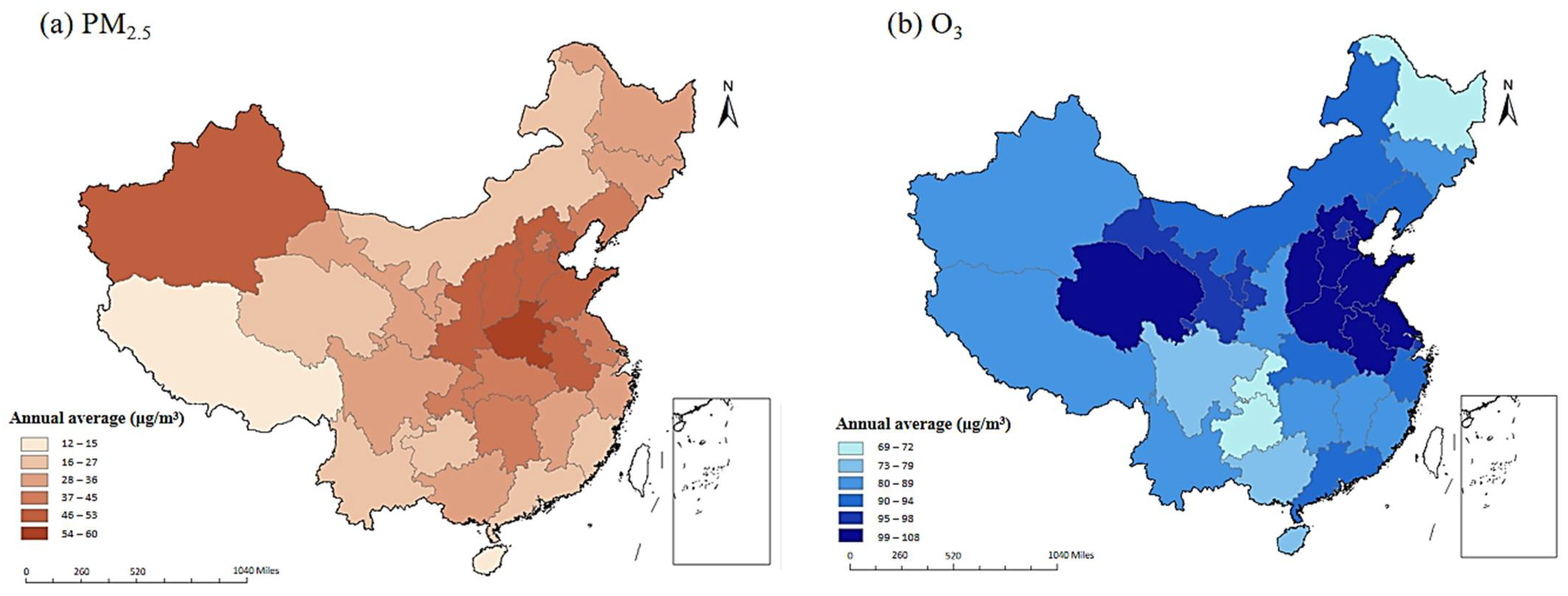

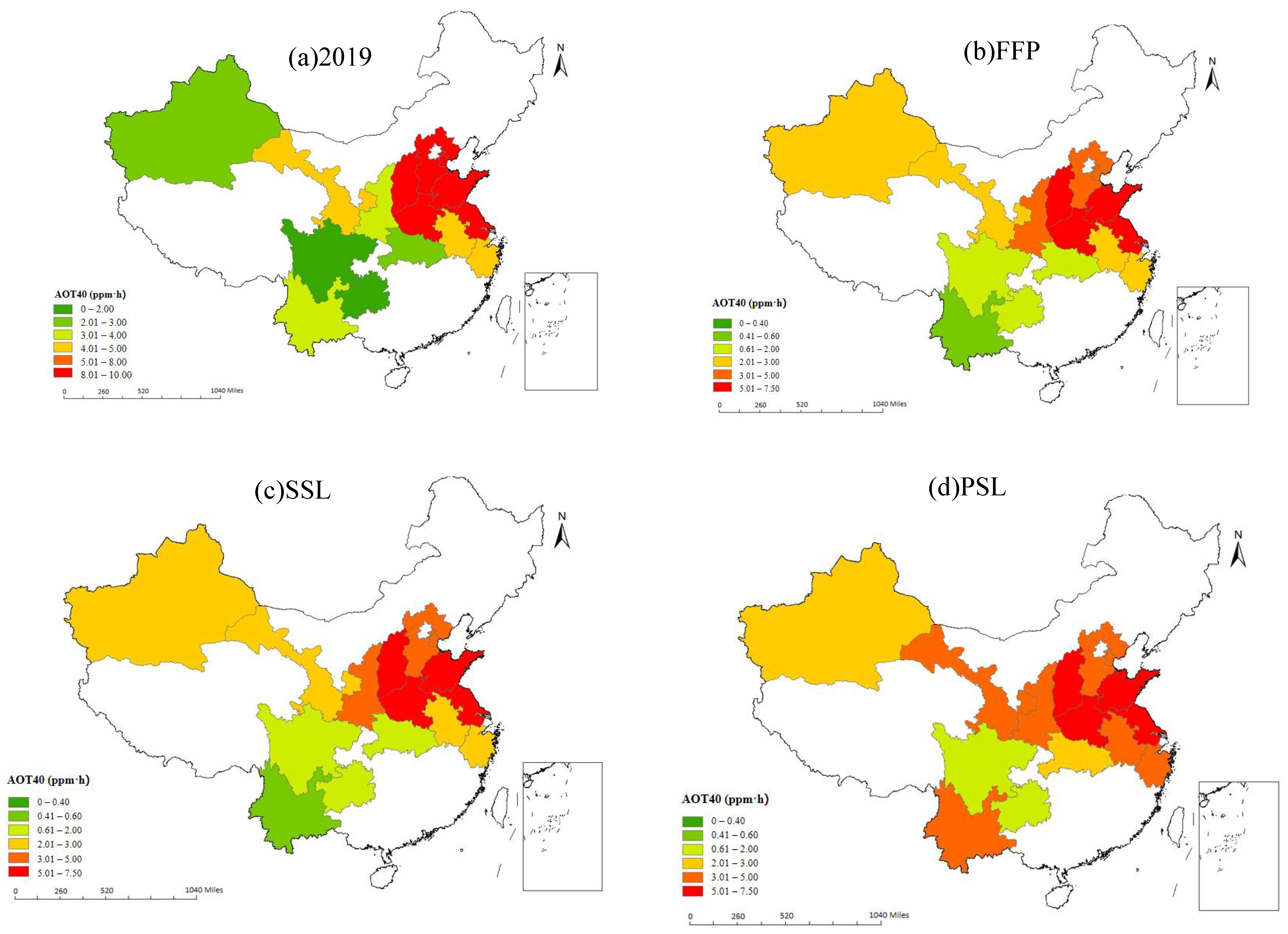


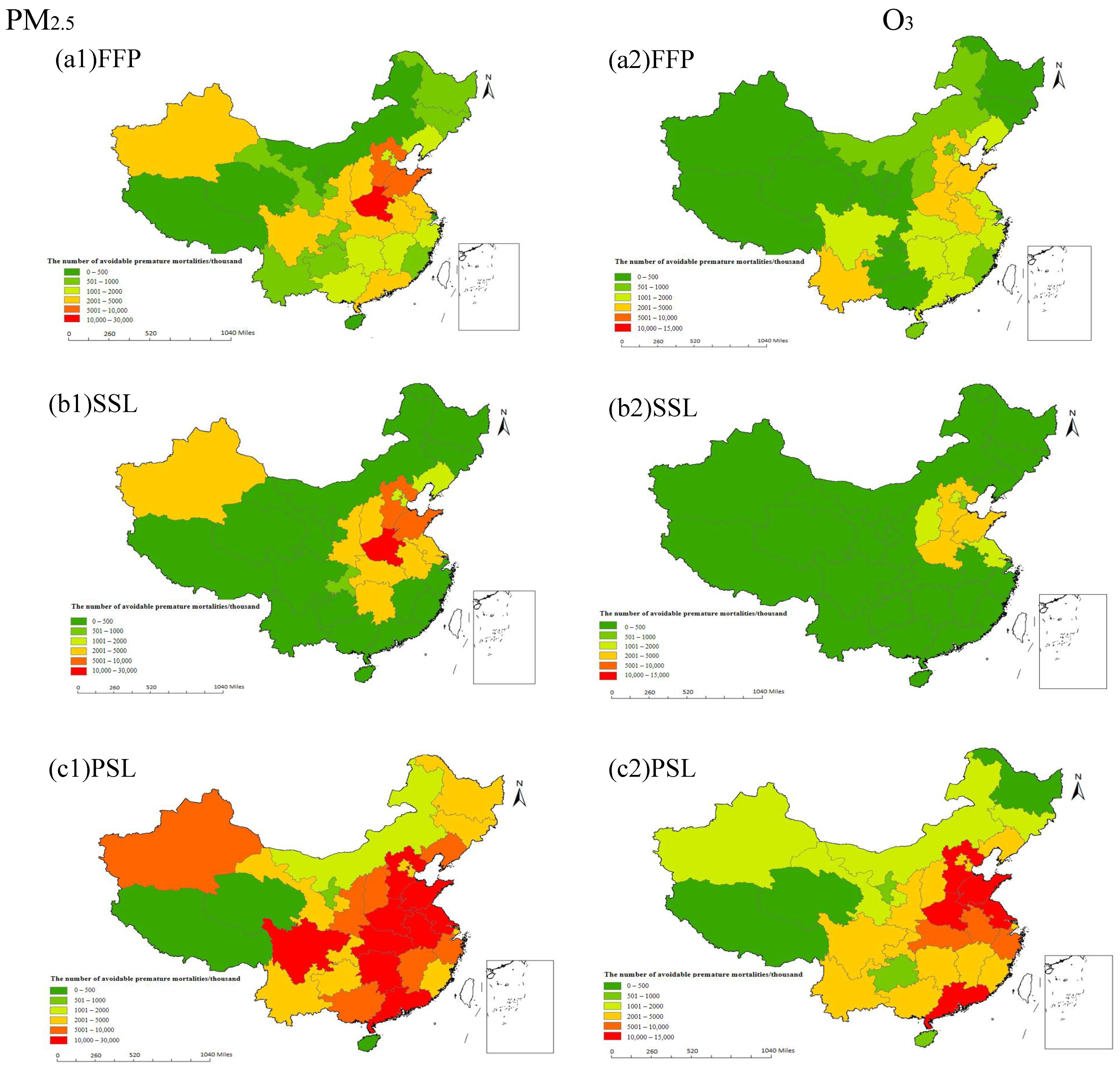
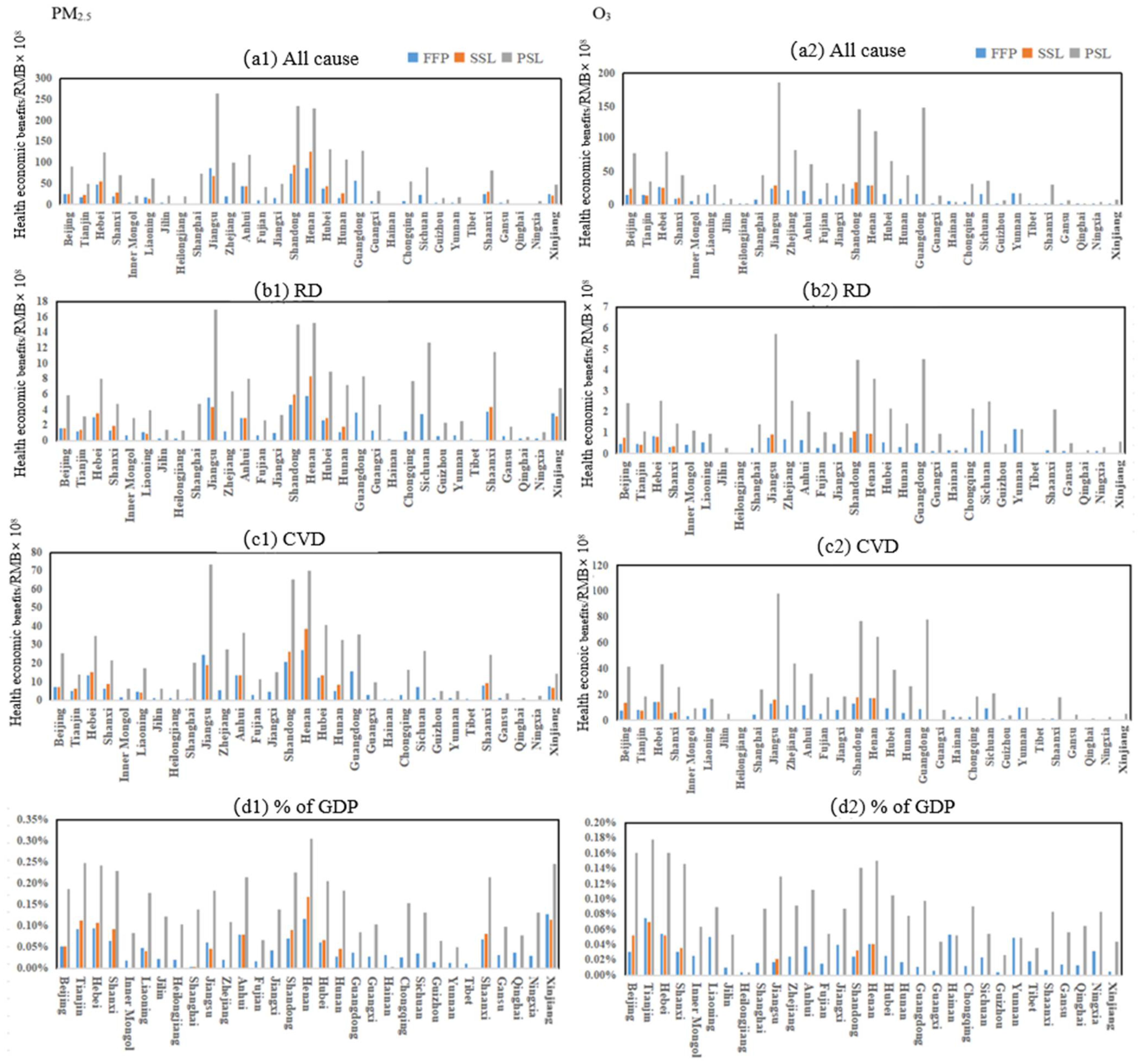
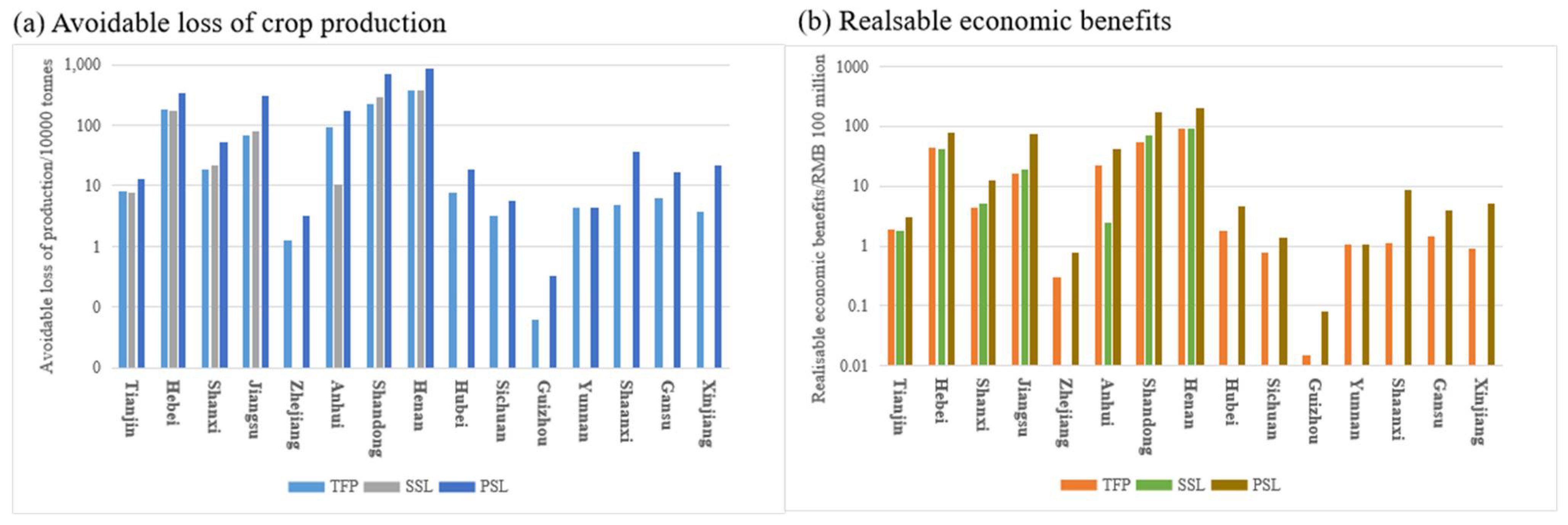
| Pollutants | Health Endpoints | (µg/m3) | |
|---|---|---|---|
| O3 | All-cause RD CVD | 0.00024 (95% CI: 0.00013–0.00035) (95% CI: 0.00013–0.00035) | 70 |
| RD CVD | 0.00018 (95% CI: 0.00011–0.00047) | ||
| CVD CVD | 0.00024 (95% CI: 0.0001–0.00044) | ||
| PM2.5 | All-cause RD CVD | 0.0009 (95% CI: 0.0003–0.0018) (95% CI: 0.00013–0.00035) | 10 |
| RD CVD | 0.00143 (95% CI: 0.00085–0.00201) | ||
| CVD CVD | 0.00053 (95% CI: 0.00015–0.0009) |
| Scenarios | Health Economic Losses from PM2.5 Pollution (RMB × 108) | Health Economic Losses from O3 Pollution (RMB × 108) | ||||
|---|---|---|---|---|---|---|
| All-Cause | RD | CVD | All-Cause | RD | CVD | |
| 2019 | 1965.09 | 255.84 | 548.86 | 1558.07 | 95.04 | 821.62 |
| BAU | 2780.33 | 219.41 | 810.3 | 2202.81 | 81.17 | 1209.42 |
| FFP | 2078.55 | 165.09 | 604.68 | 1858.97 | 68.39 | 1020.04 |
| SSL | 2171.17 | 175 | 630.52 | 2030.14 | 75.78 | 1115.96 |
| PSL | 487.65 | 39.94 | 140.95 | 780.13 | 30.23 | 430.18 |
Disclaimer/Publisher’s Note: The statements, opinions and data contained in all publications are solely those of the individual author(s) and contributor(s) and not of MDPI and/or the editor(s). MDPI and/or the editor(s) disclaim responsibility for any injury to people or property resulting from any ideas, methods, instructions or products referred to in the content. |
© 2024 by the authors. Licensee MDPI, Basel, Switzerland. This article is an open access article distributed under the terms and conditions of the Creative Commons Attribution (CC BY) license (https://creativecommons.org/licenses/by/4.0/).
Share and Cite
Luan, Y.; Guo, X.; Chen, D.; Yao, C.; Tian, P.; Xue, L. Assessment and Prediction of Health and Agricultural Impact from Combined PM2.5 and O3 Pollution in China. Sustainability 2024, 16, 7391. https://doi.org/10.3390/su16177391
Luan Y, Guo X, Chen D, Yao C, Tian P, Xue L. Assessment and Prediction of Health and Agricultural Impact from Combined PM2.5 and O3 Pollution in China. Sustainability. 2024; 16(17):7391. https://doi.org/10.3390/su16177391
Chicago/Turabian StyleLuan, Ying, Xiurui Guo, Dongsheng Chen, Chang Yao, Peixia Tian, and Lirong Xue. 2024. "Assessment and Prediction of Health and Agricultural Impact from Combined PM2.5 and O3 Pollution in China" Sustainability 16, no. 17: 7391. https://doi.org/10.3390/su16177391






